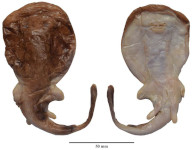Benthobatis kreffti
Rincon, Stehmann & Vooren, 2001
Brazilian blind electric ray
Classification: Elasmobranchii Torpediniformes Narcinidae
Reference of the original description
Results of the research cruises of FRV 'Walther Herwig' to South America. LXXIV. Benthobatis kreffti n.sp. (Chondrichthyes, Rajiformes, Narcinidae), a new deep-water electric ray from off South Brazil and the third species of the genus. Archives of Fishery and Marine Research, 49(1), 45–60
Results of the research cruises of FRV 'Walther Herwig' to South America. LXXIV. Benthobatis kreffti n.sp. (Chondrichthyes, Rajiformes, Narcinidae), a new deep-water electric ray from off South Brazil and the third species of the genus. Archives of Fishery and Marine Research, 49(1), 45–60
Image of the original description
Image in copyright.
Image in copyright.
Types
Benthobatis kreffti
Holotype: MZUSP: 51293; Paratype: AMS: I.39784-001; DZVU: P 3673; DZVU: P 3674; FURG: 920009; FURG: 920010; HUMZ: 162797; HUMZ: 162796; MNHN: 1997-853; MNHN: 1997-852; MOVI: 10210; MZUSP: 51294; MZUSP: 127609 (formerly MZUSP 51294); MZUSP: 127610 (formerly MZUSP 51294); UF: 111667; UF: 102494; USNM: 343645; ZIN: N 51291; ZMH: 24941 (old: ISH 1989-1968 a+b); ZMH: 8867; ZMH: 8866; ZMH: 24941 (old: ISH 1989-1968);
Benthobatis kreffti
Holotype: MZUSP: 51293; Paratype: AMS: I.39784-001; DZVU: P 3673; DZVU: P 3674; FURG: 920009; FURG: 920010; HUMZ: 162797; HUMZ: 162796; MNHN: 1997-853; MNHN: 1997-852; MOVI: 10210; MZUSP: 51294; MZUSP: 127609 (formerly MZUSP 51294); MZUSP: 127610 (formerly MZUSP 51294); UF: 111667; UF: 102494; USNM: 343645; ZIN: N 51291; ZMH: 24941 (old: ISH 1989-1968 a+b); ZMH: 8867; ZMH: 8866; ZMH: 24941 (old: ISH 1989-1968);
Description :
Citation: Benthobatis kreffti Rincon, Stehmann & Vooren, 2001: In: Database of modern sharks, rays and chimaeras, www.shark-references.com, World Wide Web electronic publication, Version 04/2025
Please send your images of "Benthobatis kreffti" to info@shark-references.com

Benthobatis Kreffti Rincon, Stehmann & Vooren, 2001 © Mariana Martins, Brazil

Benthobatis Kreffti Rincon, Stehmann & Vooren, 2001 © Mariana Martins, Brazil
Common names
 Brazilian blind electric ray
Brazilian blind electric ray
 Brazilian blind electric ray
Brazilian blind electric ray
Short Description
Original diagnosis after RINCON, STEHMANN & VOOREN, 2001 [3289]: A very small (maximum TL less than .300 mm) blind electric ray, with eyes totally concealed by integument and hardly discernible externally, with two very small, fleshy dorsal fins and a low, elongated oval caudal fin. Specimens sexually mature at about 150 mm TL. Mouth with straight jaws, narrow and protractile as a tube and surrounded by a groove being much deeper along upper jaw and around jaw angles than along lower jaw; 9 to 13 tooth rows. Lateral ridges or keels along caudal peduncle missing. Dorsal side of disc and tail dark coloured, ventral side whitish with dusky margins of disc and pelvic fins. Most specimens with a fringe of whitish free ceratotrichia at upper and posterior margins of unpaired fins.
Original diagnosis after RINCON, STEHMANN & VOOREN, 2001 [3289]: A very small (maximum TL less than .300 mm) blind electric ray, with eyes totally concealed by integument and hardly discernible externally, with two very small, fleshy dorsal fins and a low, elongated oval caudal fin. Specimens sexually mature at about 150 mm TL. Mouth with straight jaws, narrow and protractile as a tube and surrounded by a groove being much deeper along upper jaw and around jaw angles than along lower jaw; 9 to 13 tooth rows. Lateral ridges or keels along caudal peduncle missing. Dorsal side of disc and tail dark coloured, ventral side whitish with dusky margins of disc and pelvic fins. Most specimens with a fringe of whitish free ceratotrichia at upper and posterior margins of unpaired fins.
Human uses
fisheries: of no interest
fisheries: of no interest
Biology
There are indications that this species is ovovivipar [19579], Maturity was first observed at 177 and 162 mm, with total length at 50% maturity of 191 and 176 mm in females and males respectively. Uterine fecundity ranged from 1-3 and was not related to female total length. [27282] Deep water species on the continental slope. Feeds on worms, isopods and amphipods.
There are indications that this species is ovovivipar [19579], Maturity was first observed at 177 and 162 mm, with total length at 50% maturity of 191 and 176 mm in females and males respectively. Uterine fecundity ranged from 1-3 and was not related to female total length. [27282] Deep water species on the continental slope. Feeds on worms, isopods and amphipods.
Size / Weight / Age
30.0 cm TL (male/unsexed; [19579]); Size at birth estimated from the largest near-term observed embryos and smallest free-swimming ray was 91-100 mm [27282]
30.0 cm TL (male/unsexed; [19579]); Size at birth estimated from the largest near-term observed embryos and smallest free-swimming ray was 91-100 mm [27282]
Dentition
Tooth bands occupying about median three fifths of jaw length only, with small teeth closely set in quincunx and in eleven rows in each jaw (9 to 13 rows, mean 11 in upper and 12 in lower jaw). Individual tooth with flat, moderately broad, oval crown; a solid, awl-shaped cusp on anterior teeth, directed horizontally inward, medially at rear margin and becoming a little shorter and rather bluntly pointed on posterior teeth. Tooth size only slightly reduced from anterior to posterior rows, shape of teeth alike in both jaws. [3289]
Tooth bands occupying about median three fifths of jaw length only, with small teeth closely set in quincunx and in eleven rows in each jaw (9 to 13 rows, mean 11 in upper and 12 in lower jaw). Individual tooth with flat, moderately broad, oval crown; a solid, awl-shaped cusp on anterior teeth, directed horizontally inward, medially at rear margin and becoming a little shorter and rather bluntly pointed on posterior teeth. Tooth size only slightly reduced from anterior to posterior rows, shape of teeth alike in both jaws. [3289]
Remarks
shark-references Species-ID=578;
shark-references Species-ID=578;
















